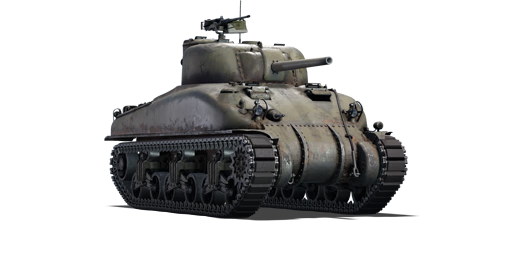The M4A1 Sherman is the first variant of the early-generation Medium Tank M4 (Sherman) family. The M4 Sherman medium tank, named after the great American Civil War general William T. Sherman, was one of the Allies' most iconic fighting vehicles during World War II, and one of the most famous tanks in history. However, while this historic distinction was achieved partly owing to its inherent virtues, it was also due to the sheer quantity of them supplied, which was only topped by the Soviet Union's T-34, with a staggering 50,000 units produced. During World War II, it was by far the most commonly utilized tank in the Allies. It developed into many different variants and had a long postwar service that lasted well into the Cold War. It was frequently compared to the T-34 and had the opportunity to engage several during the Korean War. The M4A1 was the first major variant to be introduced, in February 1942. The upper hull was entirely cast and rounded. The standard M4A1 variant was produced in 6,281 units until December 1943, when it was superseded by the late-generation M4A1 (76) W variant, which received a more powerful 76 mm M1 tank gun. Until March 1945, 3,396 of these improved variants were created. This tank was nearly identical to the M4 (second variant; early-generation), having the same engine, automotive systems, and weaponry. The main distinction was the cast upper hull. The upper hull was a single massive casting. This was a difficult task with the casting technique at the time and something the Germans could not have replicated since they did not possess the advanced technology and equipment required. Everything from hatches to wheels, turrets, and weapons could be swapped between the M4 and different Sherman variants.
Introduced in Update 1.45 "Steel Generals", the M4A1 supplies the U.S. Army ground forces with the first reliable medium tank capable of engaging enemies. The M4A1 is armed with a 75 mm M3 tank gun in a fully traversable turret and can fire a variety of ammunition depending on the situation. The M4A1 variant is distinguished by its cast hull construction, which results in a curved hull shape. This results in the hull's upper front armour plate having a varied slope angle throughout the upper glacis, but it also introduces various flaws. The first is in the frontal hull and side joints, which have relatively flat angles while angling the tank, and the second is the cast construction, which reduces the overall effectiveness of the frontal hull armour. The last are the view blocks at the frontal hull's top. Nevertheless, its armour is still effective against enemy fire from smaller calibre guns. The 75 mm M3 tank gun is positioned in the M34 gun mantlet with the periscope, a smaller gun mount than the future M34A1 gun mantlet in which all future 75 mm M4 Sherman variants will be installed. This reduces the general protection of the frontal turret but also presenting a slightly greater gun depression by -2° than future M34A1 mantlet.















